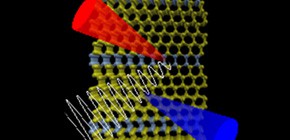
Material with greater stiffness than that of diamond verified by ultrasound spectroscopy
A group of researchers led by TANIGAKI Ken-ichi (Assistant professor), OGI Hirotsugu (Associate Professor), KUSAKABE Koichi (Associate Professor, Graduate School of Engineering Science, Osaka University) and Dr. SUMIYA Hitoshi (Sumitomo Electric Industries, Ltd.; visiting professor at Osaka University) discovered that nanopolycrystalline diamond with twinning defects had stronger interatomic bonding force than monocrystal diamond.
It has been difficult to measure the stiffness of diamond accurately with conventional ultrasonic methods because obtainable specimens are small and diamonds exhibit extremely high frequency sound velocity.
This group developed a technology for measuring the elastic constant of nano-polycrystalline diamond with twinning defects by using the wavelength of probe light shorter than that of visible light.
This group's discovery is a starting point for a new field of study in exploring defective structures with higher elastic constants. This research may lead to the development of ultrahigh-frequency resonance devices requiring high elastic constants, contributing to achieving high-frequency and high-speed mobile technological devices.
Abstract
Diamond is the stiffest known material. Here we report that nanopolycrystal diamond synthesized by direct-conversion method from graphite is stiffer than natural and synthesized monocrystal diamonds. This observation departs from the usual thinking that nanocrystalline materials are softer than their monocrystals because of a large volume fraction of soft grain-boundary region. The direct conversion causes the nondiffusional phase transformation to cubic diamond, producing many twins inside diamond grains. We give an ab initio-calculation twinned model that confirms the stiffening. We find that shorter interplane bonds along [111] are significantly strengthened near the twinned region, from which the superstiff structure originates. Our discovery provides a novel step forward in the search for superstiff materials.

To learn more about this research, please read the full research report entitled "Observation of higher stiffness in nanopolycrystal diamond than monocrystal diamond" at this page of the Nature Communications website.
Related link :
